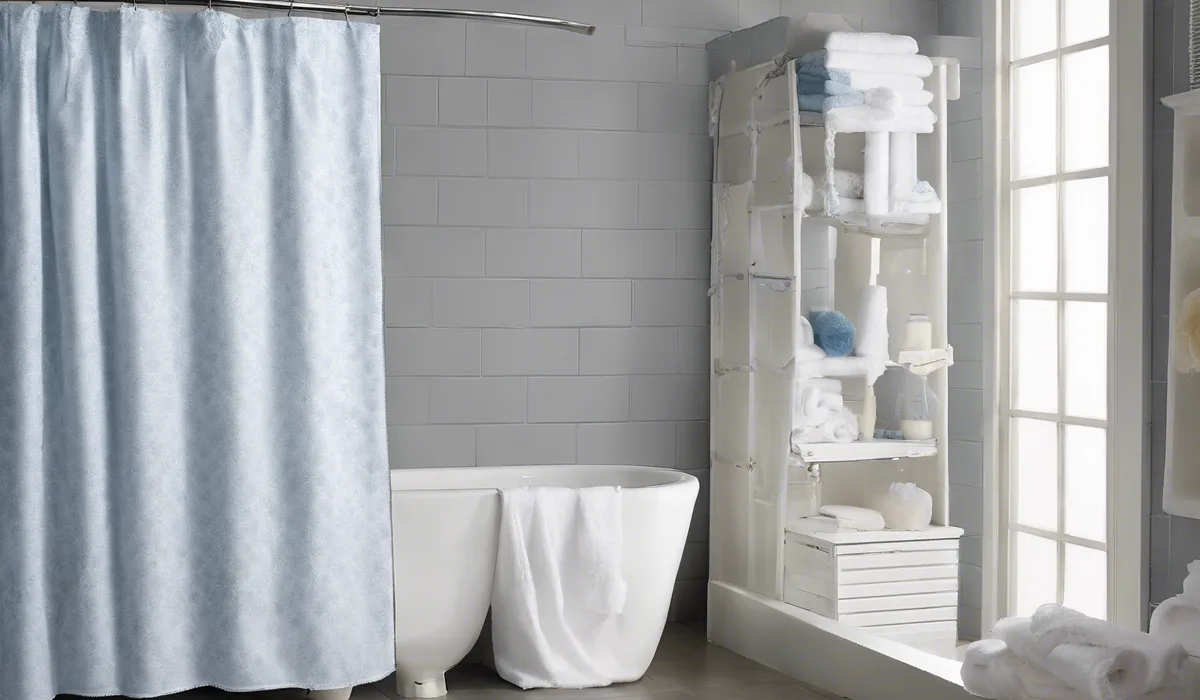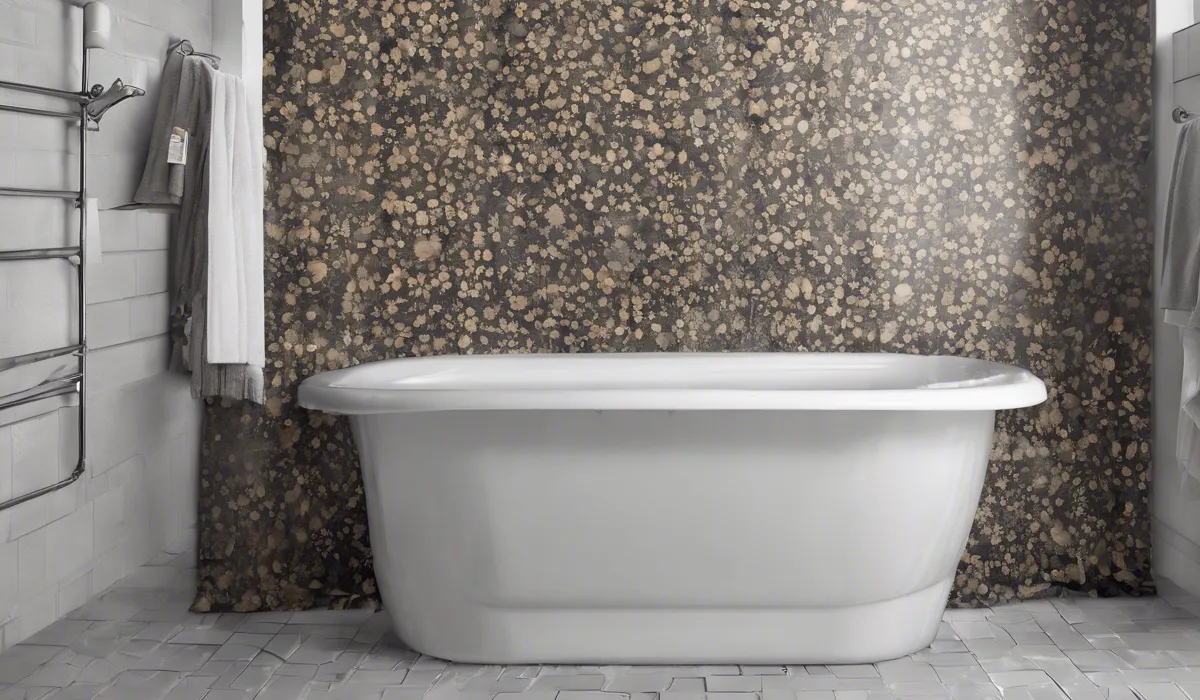To stop mold on a shower curtain, ensure proper ventilation to reduce moisture. After showering, spread the curtain to dry. Regularly wash it with a mix of baking soda and vinegar. For prevention, consider a mildew-resistant shower curtain.
Prevention Techniques

Ensuring Proper Ventilation
To stop mold on your shower curtain, the first step is to ensure proper ventilation in your bathroom.
Moist air is a breeding ground for mold, so it’s crucial to keep the air moving. Open a window or use an exhaust fan during and after you shower to help reduce moisture.
If you don’t have a window or fan, consider installing one to prevent mold growth effectively.
If an exhaust fan isn’t an option, a dehumidifier can also help by pulling excess moisture from the air.
Remember to clean vents or fans regularly to maintain their efficiency in moisture control.
Adopting Daily Habits
Daily habits can make a significant difference in minimizing dampness in your bathroom. After showering, make sure to spread the curtain out fully, which helps it dry more quickly and evenly, reducing the chance for mold to grow.
Additionally, wiping down the curtain and the walls can remove excess moisture. Finally, keep bathroom doors open when not in use to promote air circulation.
Choosing Mold-Resistant Curtains
When selecting a shower curtain, opt for mold-resistant materials. Many shower curtains today come with anti-mildew properties that make them less susceptible to mold growth.
These can be made of vinyl, polyester, or other synthetic materials that repel water and resist mold.
Although they might be a bit more expensive upfront, they can save you time and effort in cleaning in the long run.
Washing and Drying Routines
Regularly washing your shower curtain is essential to prevent mold. Every month, detach the curtain and wash it with a mix of baking soda and vinegar. This natural combination can help remove any mold or soap scum buildup.
After washing, hang the curtain back up to dry thoroughly, or use a tumble dryer on a low setting if the material allows.
Using Vinegar or Hydrogen Peroxide Solutions
Spraying your shower curtain with a vinegar or hydrogen peroxide solution can prevent mold growth. Do this weekly to keep mold at bay.
Simply mix one part of water with one part vinegar or hydrogen peroxide and spray it on the curtain. These solutions are natural and safe, without the harsh chemicals found in commercial mold removers.
Cleaning Existing Mold

Natural Cleaning Solutions
To tackle existing mold, natural cleaning solutions like vinegar, baking soda, and tea tree oil are effective and eco-friendly.
Vinegar is acidic and can kill up to 82% of mold species. Baking soda not only cleans but also deodorizes and whitens the shower curtain. Tea tree oil is a natural fungicide and can be used in a spray solution to treat and prevent mold.
Chemical Mold Removers
If natural solutions aren’t enough, chemical mold removers can be used. Be sure to follow the instructions carefully and wear gloves and a mask for protection.
It’s also advisable to keep the area well-ventilated to avoid inhaling fumes.
Step-by-Step Cleaning Process
For a thorough clean, follow these steps: Remove the curtain, apply your cleaning solution, and scrub the mold away with a brush or sponge.
Rinse the curtain thoroughly and hang it up to dry. If using a washing machine, run it on a gentle cycle with warm water and your cleaning solution.
Protective Tips While Cleaning Mold
When cleaning mold, it’s important to protect yourself. Wear gloves to prevent skin contact and a mask to avoid inhaling spores.
Ensure the room is well-ventilated, and consider wearing protective eyewear if using spray solutions to prevent irritation.
Maintenance and Replacement

Routine Inspections
Regularly inspect your shower curtain for early signs of mold. Look for discoloration or a musty smell, as these can indicate mold growth. Catching it early can make cleaning easier and prevent the mold from spreading.
Cleaning vs. Replacement
Deciding when to clean or replace your shower curtain depends on the severity of the mold. If it’s a small amount, cleaning is usually sufficient.
However, if the mold has penetrated deep into the curtain or if it keeps returning despite regular cleaning, it might be time for a replacement.
Mold-Resistant Material Recommendations
When replacing your shower curtain, consider mold-resistant materials such as PEVA or EVA.
These are plastic alternatives that are less prone to mold growth compared to traditional PVC curtains. They’re also free from chemicals like chlorides, making them a healthier choice for your home.
Scheduled Maintenance
Set a schedule for regular maintenance to prevent mold buildup on your shower curtain. This includes the weekly spraying of vinegar or peroxide solution, monthly washing, and frequent inspections.
Staying on top of maintenance will help keep your bathroom fresh and mold-free.
FAQs About Preventing Mold on Shower Curtains
How can I ensure proper ventilation to prevent mold on my shower curtain?
To ensure proper ventilation, use an exhaust fan during and after you shower, or open a window to allow moisture to escape, reducing the risk of mold growth on your shower curtain.
What should I do with my shower curtain after showering to prevent mold?
After showering, make sure to spread out the shower curtain fully to allow it to dry more quickly and evenly, which helps prevent mold buildup.
How often should I wash my shower curtain to stop mold growth?
Regularly wash your shower curtain, at least once a month, with a mixture of baking soda and vinegar to effectively remove mold and prevent its return.
What kind of shower curtain should I consider to prevent mold?
Consider purchasing a mildew-resistant shower curtain, as they are designed to repel water and resist mold and mildew growth.
Can I use any household items to clean and stop mold on my shower curtain?
Yes, you can use a homemade solution of baking soda and vinegar to clean your shower curtain and help stop mold growth.
Final Thoughts
To prevent mold on shower curtains, maintain good airflow to lower humidity and spread the curtain out to dry post-shower.
Clean it consistently using a combination of baking soda and vinegar. Opting for a curtain designed to resist mildew can further help in prevention efforts.
